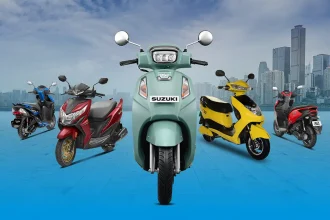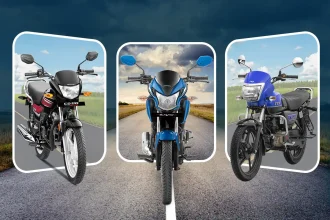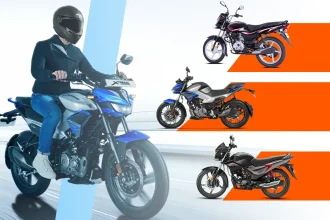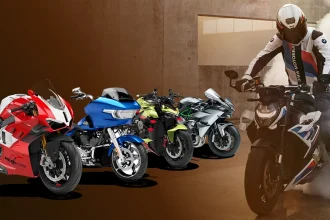If you have ever purchased a bike, then you may have heard about the term CC. When you buy a new bike, you may come across various factors but one of the most important factors is cubic capacity.
It refers to the volume of the chamber of a bike engine. In simple words, the higher the capacity is, the larger the quantity of air and fuel mixture.
If you’re looking for a new bike, then it becomes essential to understand Cubic Capacity. This blog will explain what is CC in bike? as well as how you can choose a bike with the right CC.
What is the full form of CC in the bike?
The full form of the term “CC” is cubic capacity. It refers to the volume of the bike’s engine. This capacity is used to determine the space inside the engine. The CC starts with a range of 150 CC and goes up to 1800 CC.
This CC can also impact the price range of a bike. Therefore, bikes up to 500 CC need a standard license, and bikes with a cubic capacity greater than 500 CC need a separate license.
What is the use of CC in Bikes?
Now once you understand what is CC in bike? Let us analyze its uses :
- Power: The higher CC signifies that the engine is capable of producing more power. Therefore, bikes with larger CC engines run faster and give effective performance.
- Efficiency: The CC affects the overall performance and speed of the bike in the long term.
- Air and fuel capacity: Due to their increased mixture of fuel and air usage, large CC engines use greater amounts of fuel.
What is the Difference Between CC & Mileage in Bike
| Feature | CC (Cubic Capacity) | Mileage |
|---|---|---|
| Definition | Refers to the engine displacement, measured in cubic centimeters (cc). | Refers to the distance a bike can travel per liter of fuel. It is usually measured in km/l (kilometers per liter). |
| Purpose | Indicates the engine’s size, power potential, and combustion capacity. | Measures the bike’s fuel efficiency and how far it can travel on a specific amount of fuel. |
| Impact on Performance | Higher CC usually means more power and torque, allowing for better acceleration and top speed. | Higher mileage indicates better fuel efficiency, meaning the bike consumes less fuel over longer distances. |
| Engine Size Relation | Larger CC means a larger engine with more air-fuel mixture combustion, leading to increased power output. | Mileage is inversely related to engine size. Larger CC engines tend to consume more fuel, thus giving lower mileage. |
| Ideal Use | Higher CC bikes are ideal for high-speed, long-distance, or sports-oriented performance. | High-mileage bikes are ideal for daily commuting and long-range travel where fuel economy is important. |
| Examples | A bike with 250cc has more power, suitable for highways or off-roading. | A bike with 60 km/l mileage is suitable for city commuting and fuel cost-saving. |
| Effect on Bike Weight | Generally, higher CC means a heavier engine, affecting the overall bike weight. | Bikes with higher mileage typically have smaller engines, making them lighter in weight. |
| Cost Impact | Bikes with higher CC are generally more expensive due to the larger engine and better performance. | Bikes with higher mileage are often more affordable as they prioritize fuel efficiency over raw power. |
| Preference Factor | Riders looking for performance, speed, and power may prefer higher CC. | Riders looking for cost-effective daily transportation usually prefer bikes with higher mileage. |
What is the Advantage of Higher CC on a Bike?
Now that we know what is CC in bike and its uses let us determine what is the advantage of higher CC on a bike:
- Impact power output: The engine of the bike chamber compresses the gas and air mixture to generate power. Therefore, the amount of mixture of fuel and air that could be compressed to generate power increases with cubic capacity. Additionally, higher compression can result in higher power output.
- Increased performance: The CC of the bike plays a big role in assessing speed and performance.
- Greater torque and speed: Bikes with larger CC engines can reach top speed. They can also ensure greater speeds more effectively and run faster because of their increased power.
- Suitability: Bikes that have smaller CC engines are more suited for regular travel because they provide higher mileage. The suitability is determined by riding needs. However, bikes with a higher CC will be better for off-road excursions, distant riding, etc.
How can you choose the right CC bike?
Once you get it, what is CC in a bike? The next step is to choose the bike with the right CC. The following are some significant factors
- Purpose: When choosing the CC for a bike, the intended use is a crucial factor. If you buy it for daily travel, its low to affordable cubic size will be an ideal choice. However, if you desire off-road excursions and distant traveling, choose a bike with high CC.
- Riding expertise: It is preferable to get a bike with a smaller cubic capacity when you are absolutely unfamiliar with or have no prior experience riding bikes. Before pursuing more potent solutions, it will assist you in gaining a respectable level of control over your bike.
- Psychological condition: Large bikes with high cc are more comfortable to ride. Therefore, choosing the appropriate cubic capacity for your bike requires careful consideration of your power, preferences, and health. In order to comprehend which bike best fits your skills, you are able to ride the various models.
What is the importance of CC in bikes?
CC is an important factor in bikes. It can directly influence the performance and speed of the bike. An engine with a higher CC can burn more gas and air. Therefore, it also depends on the needs and demands of the rider.
Some benefits of CC in bikes are:
- The engine produces more torque with a higher cubic capacity. It improves the speed and overall performance of the vehicle.
- Cc plays a key factor in the engine weight, and the large engine generally results in heavier bikes.
- The advancement in technology ensures fuel efficiency in the higher CC engine.
What are CC and BHP in Bikes?
Brake horsepower or BHP, gauges engine power output, whereas CC gauges its size. This BHP increases with the CC. For instance, a 500-cc bike will have increased power than a 100-cc bike.
What is CC in Bikes and Cars?
The cubic capacity has a varied effect on vehicles and motorcycles, even if CC is a common criterion for both. While CC mostly affects power and speed in bikes, it also affects engine torque, which is crucial for transporting people and goods in cars.
How do you Calculate the Cubic Capacity of your Bike?
The company provides all the calculations regarding the cubic capacity. So you don’t need to worry about it. Here are some simplest ways to calculate the CC:
- Find the bare, which is the diameter of each cylinder, and the strake, which is the length of the piston stroke.
- Multiply the bare diameter against itself and then with strake length. 3.14/4 *bare*bare*strake)
- Divide by the number of cylinders.
- Divide the obtained number by 1000 and round it to the nearest value for accurate results.
What is the Highest CC Bike in the World?
With an incredible 8,300cc engine, the Dodge Tomahawk is at present the highest CC bike in the world. Although it is not a business model that can be used on the road on a daily basis, this futuristic bike is made for high speed.
What is CC in Bike and Mileage?
A bike CC influences both fuel and energy efficiency. Generally, bikes with larger displacements, such as 200 cc and up, can provide more energy but use more gas. This reduces mileage.
How CC Affects Insurance Premiums
The bike’s cubic capacity (CC) significantly affects insurance premiums. A higher CC indicates more engine power, leading to higher speeds and potentially greater risks, which increases insurance costs. Bikes with a higher CC generally have higher premiums because they are associated with increased accident risk, higher repair costs, and more severe damages. Conversely, lower CC bikes usually attract lower insurance premiums due to their reduced risk profile.
Conclusion
A cubic capacity, or CC for short, is the engine chamber’s volume in cubic feet. It determines how much air and fuel can be pressed to provide the engine’s power on your bike. It has a big impact on the cost, insurance, as well as efficiency of your bike. It also establishes the bike’s performance and abilities for the riding environment. Therefore, this blog can help you determine what is CC in a bike? and why it is one of the main factors in choosing an ideal bike for you.
Frequently Asked Questions ( FAQs)
What is engine cc in bikes?
Engine CC (cubic capacity) in bikes refers to the volume of the engine’s cylinders, measured in cubic centimeters. It indicates the amount of air and fuel that can be combined for combustion within the engine. Generally, a higher CC value means more engine power, better performance, and higher speeds. However, it also means increased fuel consumption and, often, higher insurance premiums.
What does CC stand for in bikes?
CC stands for Cubic Capacity, which refers to the engine’s volume or the capacity of the engine’s combustion chamber.
How is CC related to a bike’s performance?
The higher the CC, the more fuel and air the engine can take in, generally resulting in higher power and performance.
Does higher CC mean a faster bike?
Typically, yes. A higher CC usually means a more powerful engine, which can result in higher speeds.
How does CC affect fuel efficiency?
Higher CC bikes tend to consume more fuel, making them less fuel-efficient compared to lower CC bikes.
Does a higher CC mean a smoother ride?
Not necessarily. While higher CC engines may provide more power, factors like suspension and bike design also impact ride smoothness.
How does CC impact the insurance premium of a bike?
Bikes with higher CC typically have higher insurance premiums due to increased risks associated with greater power and speed.
What is a good CC range for beginner riders?
A CC range of 100-150 is generally recommended for beginners as it offers manageable power and good fuel efficiency.
Does CC impact bike registration costs?
In many places, higher CC bikes may have higher registration and road tax costs.
Why do some bikes with similar CCs have different performance levels?
Performance also depends on factors like engine tuning, weight, aerodynamics, and overall design of the bike.















